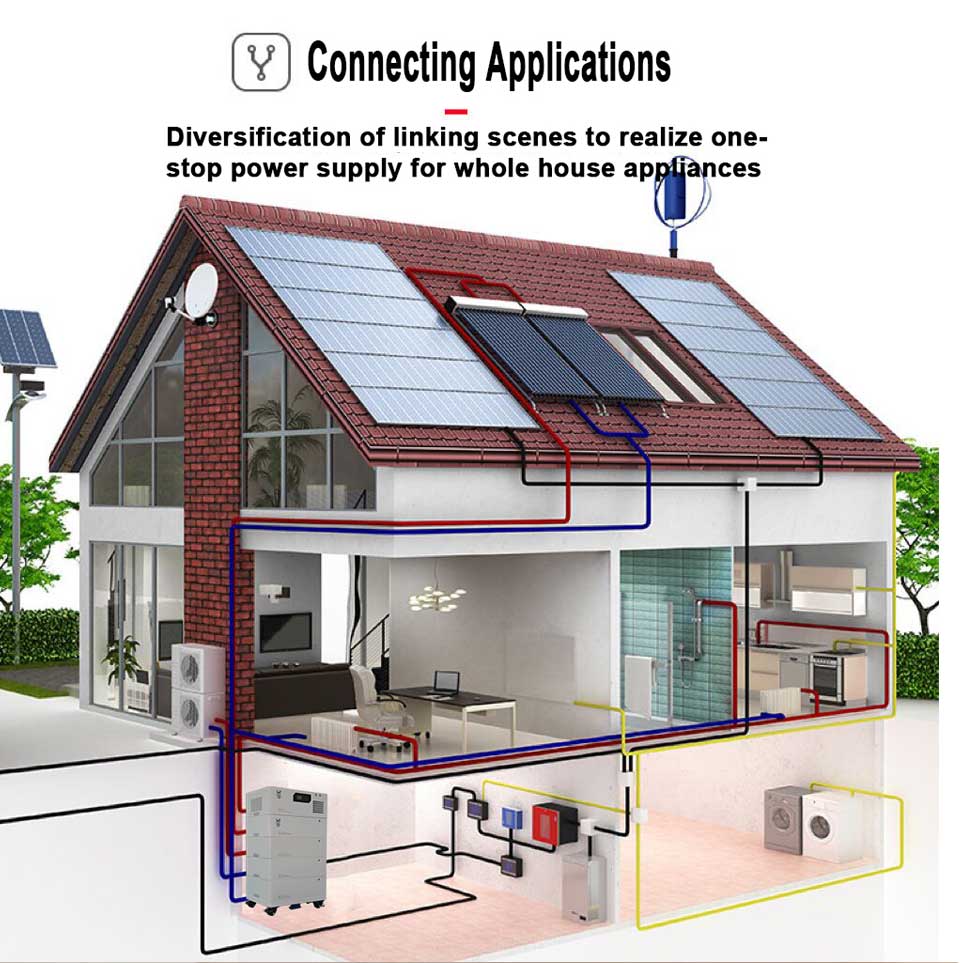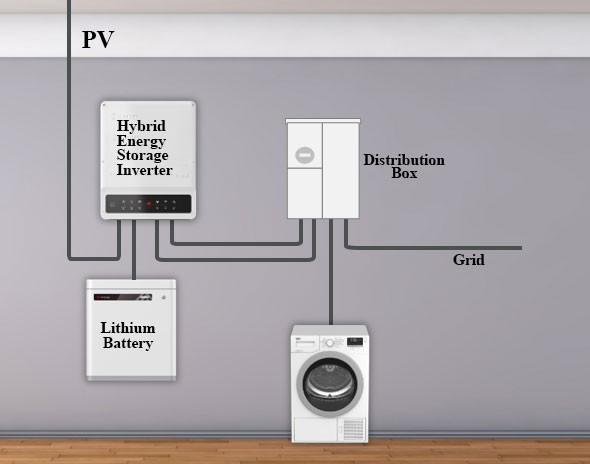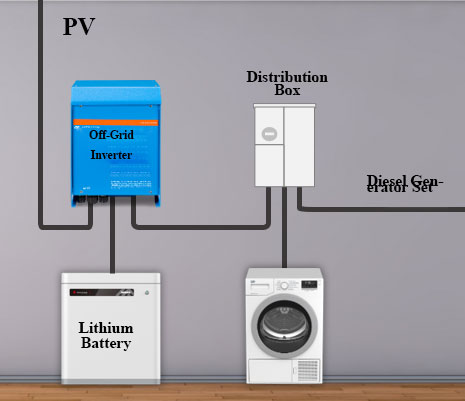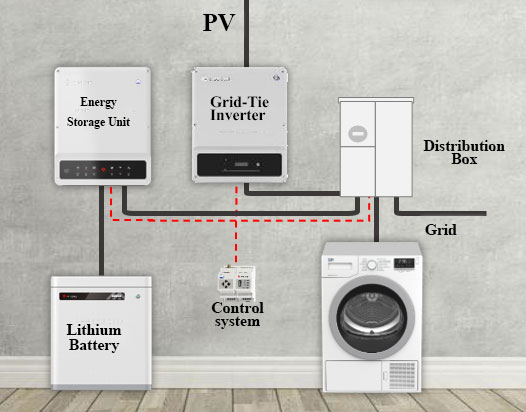Domestic energy storage solutions are designed for household settings, often paired with residential solar PV systems, to supply power to homes. Reducing electricity bills is a key motivator for households to adopt storage. Typically, residential energy consumption peaks in the evenings, creating a mismatch between solar generation hours and actual usage. Energy storage enables users to store excess electricity generated during daylight hours for later use at night. Moreover, electricity tariffs vary throughout the day with peak and off-peak rates. Storage systems can capitalize on this by charging during off-peak hours, either from the grid or via the home's own solar panels, and then discharge during peak periods to power household loads. This strategy avoids drawing power from the grid during expensive peak times, significantly cutting down on electricity expenses.

Residential photovoltaic-energy storage (PV-ESS) systems are centered around solar panels, batteries, and energy storage inverters (bi-directional converters). By integrating residential energy storage with solar PV, a comprehensive residential PV-ESS system is formed, which primarily includes battery cells, energy storage inverters, and PV component systems, among other components.A typical configuration often entails a 5 kW (panels plus inverter) setup paired with a 10 kWh storage battery, or a scaling up to 10 kW coupled with 10 kWh of storage. Within this setup, battery cells, being the crux of the storage system, account for approximately 45-50% of the total cost. The energy storage inverter, responsible for managing charging and discharging processes as well as converting between direct and alternating current, contributes to about 10-15% of the costs. The PV system, which harnesses solar energy, makes up roughly 20-25% of the expenses. Installation costs have seen an increase from around 10,000 RMB in 2021 to about 20,000 RMB, now representing 15-20% of the overall investment.Below are four common types of residential PV-plus-storage systems along with their characteristics, offering insights into prevalent options in the market:

A hybrid photovoltaic (PV)+ energy storage system typically comprises photovoltaic modules, lithium batteries, a hybrid inverter, a smart meter, CT sensors, the grid, grid-tied loads, and off-grid loads. This system enables direct DC-DC conversion for charging batteries from solar power and bidirectional DC-AC conversion for both charging and discharging the battery.
During the day, solar power is first used to supply connected loads, followed by charging the battery. Any excess energy is then fed back into the grid. At night, the battery discharges to supply loads, with the grid supplementing any shortfall. In case of a grid outage, only the photovoltaic output and the lithium battery power the off-grid loads, rendering grid-tied loads inaccessible. Additionally, the system allows users to customize charge and discharge schedules to meet their specific electricity needs.
•Highly integrated, significantly reducing installation time and costs.
•Enables smart control to cater to users' electricity demands.
•Provides a secure power supply to users during grid outages, ensuring electrical safety and continuity.
The coupled PV+ storage system, also known as an AC-coupled PV+ storage system, typically features photovoltaic panels, grid-tied inverters, lithium batteries, AC-coupled storage inverters, smart meters, CT sensors, the utility grid, grid-connected loads, and off-grid loads. It operates by converting solar power into alternating current (AC) through the grid-tied inverter, then directing surplus energy through the AC-coupled storage inverter to be transformed back into direct current (DC) for battery storage.
During daylight, solar power primarily caters to immediate loads, then charges the battery, with any excess being exported to the grid. At night, the battery discharges to support loads, with the grid providing supplementary power if needed. In the event of a power outage, only off-grid loads are serviced by the battery, while grid-tied loads remain inactive. Users can customize charging and discharging schedules to align with their energy consumption patterns.
•Facilitates cost-effective retrofitting of existing grid-tied PV systems into storage-equipped setups.
•Ensures a secure power supply during grid failures, enhancing electrical safety for users.
•Offers compatibility with PV systems from different manufacturers, enhancing flexibility and adoption potential.

An off-grid residential PV+ storage system typically consists of photovoltaic panels, lithium batteries, an off-grid storage inverter, connected loads, and a diesel generator. This setup allows for direct DC-DC conversion from solar to charge batteries, as well as bidirectional DC-AC conversion for charging and discharging the battery.
During daylight hours, solar power primarily powers the loads, followed by recharging the battery. At night, the battery discharges to supply the loads, with the diesel generator kicking in to supplement when the battery level is insufficient.
•Adequately addresses the daily electricity needs of areas without access to the main power grid.
•Integrates seamlessly with a diesel generator, which can either directly power loads or recharge the battery, enhancing system reliability.
•Most off-grid storage inverters lack grid-tied certification, meaning even if a grid connection is available, the system cannot synchronize with it, ensuring off-grid exclusivity and safety.

A photovoltaic energy storage management system typically encompasses photovoltaic modules, grid-tied inverters, lithium batteries, AC-coupled storage inverters, smart meters, CT sensors, the grid, and a control system.
System Characteristics:
•The control system is designed to receive external commands and respond to real-time energy demands, enabling efficient control and scheduling of the system.
•It facilitates optimized grid operation, enhancing energy efficiency and economy.
•The residential energy storage market is predominantly overseas, with a significant focus on regions like Europe, the United States, and Australia, where energy prices and residential electricity tariffs are high. In contrast, the Chinese market currently prioritizes grid-side storage projects due to domestically lower residential electricity rates, especially compared to regions like Europe, the U.S., and Australia, where the economic benefits of household energy storage systems are less pronounced.
Market Overview: Europe currently leads as the world's largest residential storage market, experiencing rapid growth. Factors such as the expansion of renewable energy, supportive policies, rising installations of home PV systems, increasing energy costs, high residential tariffs, and widening peak/off-peak price differences are fueling the boom in user-side storage projects globally.
In 2019, the EU initiated the "Clean Energy Package" (CEP), strongly promoting residential storage. Further in 2022, with the "REPowerEU" plan, the EU intensified investments in renewable energy sectors and accelerated PV system deployments. Resolute policy implementation and high energy costs for residents are driving the exponential growth of the European residential storage market. By 2020, Europe's cumulative residential storage installations reached 1.8 GWh, marking it the largest market. In 2021, Europe added 2.8 GWh of storage capacity, with residential storage remaining a key component; Germany alone accounted for 430,000 installed residential storage systems.
In 2022, Europe's residential storage installations continued their high-growth trajectory, with Germany emerging as the world's largest residential storage market. Other countries like Italy, the UK, Czech Republic, Poland, etc., are also witnessing accelerating residential storage system installations. Projections indicate that Europe's residential storage market will see installations of 10 GWh in 2022 and 23 GWh in 2023.
Driven by favorable storage policies and rising energy prices, the pursuit of economic and stable electricity supply by overseas residents is propelling the rapid expansion of the residential storage market. In 2021, global new residential storage installations reached 1.91 GW, equivalent to 4.36 GWh in battery capacity.
Market Outlook: The residential storage market is experiencing a phase of rapid expansion. According to a report by Dongwu Securities, the global residential storage installation scale is forecasted to hit 15 GWh in 2022, with shipments reaching 24 GWh. By 2025, the global residential storage installation capacity is expected to attain 50 GW, equating to 122 GWh in battery capacity, with shipments projected at 196 GWh.This growth underscores the international momentum behind residential energy storage solutions as a pivotal tool for enhancing energy independence, efficiency, and sustainability amidst a shifting global energy landscape.
Choosing between single-phase and three-phase po
"Revolutionizing energy storage, advancements in
Here is an introduction to one of the best batte
Contact: Thomas
Phone: +8618025306280
Tel: +86-0755-32872175
Email: hello@raderenergy.com
Add: Block A, Ketujia Building, Fucheng Street, Longhua District, Shenzhen, PRC